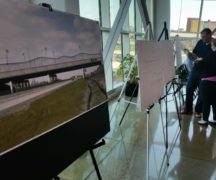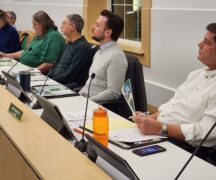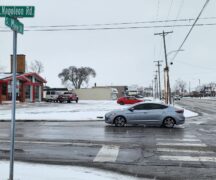By JAN LARSON McLAUGHLIN
BG Independent News
Bowling Green’s budget for 2018 doesn’t dazzle – but it also doesn’t drag down the city with a projected deficit.
“It’s a budget that gets our head above the water,” said Municipal Administrator Lori Tretter as she introduced the 2018 budget to City Council and city employees Wednesday evening. “And that’s OK.”
Last year at this time, Tretter broke the news to council members that the city was entering 2017 with a projected deficit of $625,000. So a balanced budget for 2018 was pretty dazzling to council.
“When we stood here a year ago – that’s not where we were,” Tretter said.
Council member Bob McOmber, who has served as finance committee chairman for the past eight years, said he would much rather see a “mundane” balanced budget. “It certainly looks better than the deficit we were facing last year.”
The city budget, McOmber said, consists of many moving parts. “There are a lot of inter-related parts in the budget.” So getting it to balance is a feat.
One reason for the additional projected revenue is a 3 percent increase expected in city income tax revenue. Modest increases are also projected in court activity and investment interest. The other big revenue boost is due to the decision made by City Council last year to start charging a fee for trash and recycling pickup.
Council president Mike Aspacher said council went through serious deliberation of several options before enacting a trash fee.
“That was a really difficult decision for all of us,” Aspacher said. But the fact that the budget for next year is in the black justifies the decision. “This budget proves it was really necessary for us to do.”
Aspacher also pointed out some surprising stats in Tretter’s report. The city’s 2008 general fund budget expenditures were $17.1 million, while the 2017 adopted budget was $15.6 million. The number of non-utility and non-parks and rec employees numbered 232 in 2008, compared to 212 now.
“We’re finding a way to provide services at the same level,” for less money and with fewer people, he said.
Though most of the City Council’s wish list is still not affordable, Bowling Green will be adding a couple positions that have long been on the waiting list. The one new position will be a sustainability coordinator, who will help educate the community on issues like mulching and recycling. Another position to be reinstated next year is one of the several equipment operator jobs that have gone unfilled in recent years.
Both the fire and police divisions were given credit for cutting down on their overtime expenses.
But the street fund continues to be a “challenge,” Tretter said, with spikes in funding and increasing costs.
The city parking lot revenue is flat. “This is a concern of ours,” she said. “We cannot continue to defer the maintenance of those parking lots.” The city may have to borrow money for the improvements to spread over a 10-year period.
The city already has debt for city pool improvements and the North Main Street widening. New debt may be acquired for utility work for the roundabouts at Interstate 75 and for the new building proposed in City Park.
The city is also setting aside $25,000 to help with the implementation of the Community Action Plan. The recommendations of the CAP program will be presented in January.
Despite the good news about a balanced budget for 2018, Aspacher cautioned that the city’s finances by watched carefully.
“We cannot ignore the fact that we continue to have a structural deficit in our general fund,” he said. “There’s just too much at risk for us to fall out of balance again.”
Council member Sandy Rowland agreed. “We just put a Band-Aid on it in 2017.”
Rowland asked McOmber to share his budgeting wisdom with council before his term is up at the end of the year.
McOmber said the continued loss of state funding is still a major concern. “Our financial future is somewhat uncertain,” he said. “There’s still that same cloud over the horizon.”
Mayor Dick Edwards thanked City Council for addressing the deficit and putting the new trash fee in place. The $13 fee per residence will allow the city to “keep our heads above water,” he said.
Finance Director Brian Bushong, who called himself the “Eeyore in the room,” said many requests did not make the cut for the budget. Following are some of the expenses in the 2018 budget:
- Payments to outside entities, like Wood County Airport, $26,347; Wood County Law Library, $75,000, Disaster Services, $16,543; Wood County Auditor Real Estate Collection, $45,000; community fireworks, $5,000; Special Improvement District for city-owned downtown property, $34,916; tax revenue sharing with Center and Plain townships, $111,000; Convention and Visitors Bureau, $221,480.
- General road paving, $300,000.
- Ambulance remount, $220,000 ($45,000 was in the 2017 budget).
- Fire utility vehicle, $34,000.
- Reserve funding for new fire engine, $50,000.
- Police cruiser, $43,475.
- Arborist pickup, $54,000.
- Street sweeper lease, $42,500.
- Garbage truck retro-fit, $155,000.
- Police and fire dispatch upgrades, $55,000.
- Bicycle Safety Commission, additional $3,800 for education.
- BG Transit, $67,009.
- Payroll Stabilization Fund to prepare for the year 2021, which will have 27 pay periods, $35,000.
- Green Space Acquisition Fund, $36,012.
- 50/50 sidewalk repair program, additional $25,000.
- Planning department, $20,000 for digital archiving and GIS update.





